What is poisson cru?
Poisson cru is a dish made from fresh or canned coconut milk.
The recipe is simple and easy to follow, and it takes more time to make than most dishes, but the results are worth it. Poisson cru is a French dish made from fresh or canned coconut milk.

What are the main ingredients in poisson cru?
- Sushi grade raw fish
- Lime
- Cucumber
- Coconut milk (canned)
- Red Onion
- Ginger
- Carrot
- Bell Pepper
How to make poisson cru?
Step 1: Choose your fish
Choose high-quality, fresh fish for this dish. Add other vegetables or fruits to customize the flavor. A pinch of sugar can be added to take the edge off the dish’s acidity. Tahiti is a good choice for this dish because it has a mild flavor and is high in protein. Other options include halibut, snapper, swordfish, and cubed red peppers. Coconut milk gives this recipe a slightly sweet flavor and makes it light and refreshing
Step 2: Choose your fresh vegetables
In order to prepare fresh vegetables for poisson cru, you will need lime juice, coconut milk, salt and pepper. You can optionally add shredded cabbage, cabbage, cucumbers, bell pepper, etc.. to the recipe.
Step 3: Prepare your Tahitian poisson cru marinade
To prepare the Tahitian poisson cru marinade, you will need:
- a lot of lime juice
- dash of salt and pepper to taste
Step 4: marinate the raw fish
Rinse the fish in well-salted water for a few minutes then drain.
Mix the fish with lime juice and place in fridge for 8-12 minutes.
Step 6: Prepare the vegetables
Dice the tomatoes, cube the green bell pepper, peel and largely dice the cucumber, peel and grate the carrot, dice the red onion, bruise the garlic and ginger. Then, In a large bowl combine the bell pepper, carrot, cucumber, red onion, garlic, tomato and ginger.
Step 5: Combine and serve
To make poisson cru, mix together the fish and vegetable ingredients. Mix well and garnish with scallions or sesame seed if desired. Serve cold.

FAQs
How is this Tahitian poisson cru different than Latin ceviche
Poisson cru is a dish made from fish and vegetables chopped up coarsely. The dish differs from Latin ceviche in the type of fish used and in the way the vegetables are chopped. Poisson cru is also different from Latin ceviche in that the vegetables are coarsely chopped rather than finely diced, and poisson cru has coconut milk whe
The ingredients are marinated briefly before being served cold.
How long does poisson cru last?
Poisson cru lasts about three to four hours. The ingredients for this dish include tuna, lime juice, and coconut milk. This dish is easy to prepare and can be enjoyed as an appetizer or a light meal. A cooking lesson with Tikehau Pearl Beach Resort can teach you how to make this delicious and healthy dish.
Why we love this recipe
This was a recipe that we were both really looking forward to, and for good reason.
When we first came across it, poisson cru struck us as a rich and vibrant ahi tuna salad with an added twist of coconut milk.
Really… who wouldn’t want to try a recipe mixing tastes of raw (okay, slightly ceviche “cooked”) fish, fresh vegetables and smooth coconut milk?
We were hooked from the start.
If you are interested in the raw food diet, you might want to check our our bircher muesli oats with fruits recipe. You’ll also find information in there about the grandfather of raw foods, and how the raw food diet came about.
Tahiti and its Poisson Cru
Well-known as a luxurious tourist destination and for its beautiful weather, Tahiti is one of the largest and most recognizable islands in French Polynesia, itself a set of 118 separate islands (wow!) closely clustered together in the Pacific Ocean. The French Polynesian islands are considered to be one of the last places on Earth to have become inhabited with humans, with the first settlers coming only a few thousand years ago.
These islands came into contact with European colonists – from the Portuguese to the British to the French – before ultimately being annexed as a French colony in 1880. Today, Tahiti and the rest of these islands are French territories with completely civil and political rights as mainland French citizens, and the official language spoken is recognized as French.
However you’d like to call it, poisson cru will be as close to a Tahitian national dish as you’ll get. Eating establishments of all shapes and sizes, from the roulettes food carts to the to-go aisles of supermarkets to the fine dining restaurants, will most likely have some version of poisson cru available on their menus.
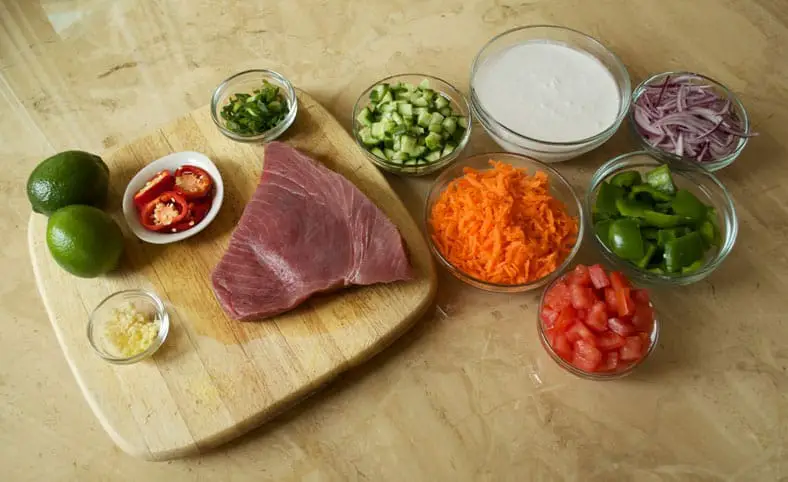
About the Recipe
One thing that’s really inspiring about Tahitian cuisine is how each recipe yields such exquisite tastes from ingredients that are readily available and abundant throughout the land. It seems as close to this notion of “sustainable eating” as you’ll get.
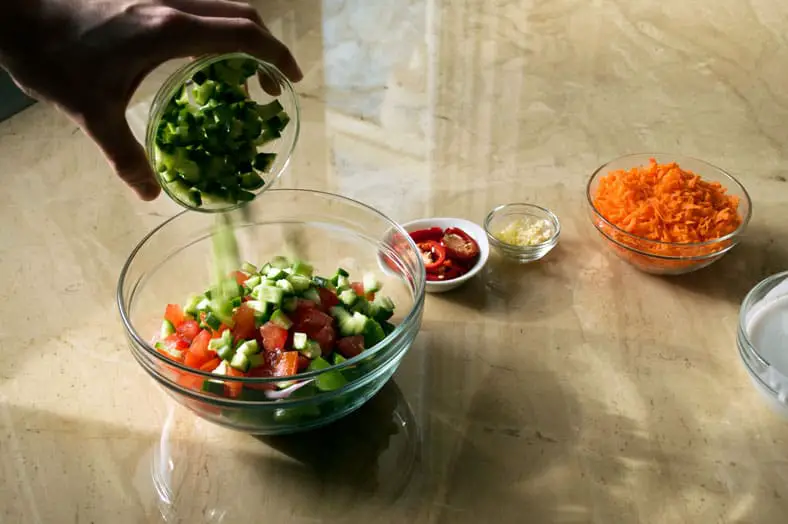
Poisson cru is certainly no exception. It is an incredibly simple recipe that highlights the traditional ingredients common to most Tahitian recipes.
At the heart of the recipe is raw fish, hence giving the poisson cru recipe its namesake. Technically, the name suggests that any type of local and raw fish can be used, although most recipes that we came across used raw sushi-grade tuna.
Much in the same way ceviche is prepared in South American countries, the raw fish will “cook” slightly in a marinade of citrus juice and salt. In this type of preparation, there’s no real cooking with heat going on, but the citric acid from the citrus juices triggers the same denaturation processes to the meat’s proteins as heated cooking will do, if even for only a moment.
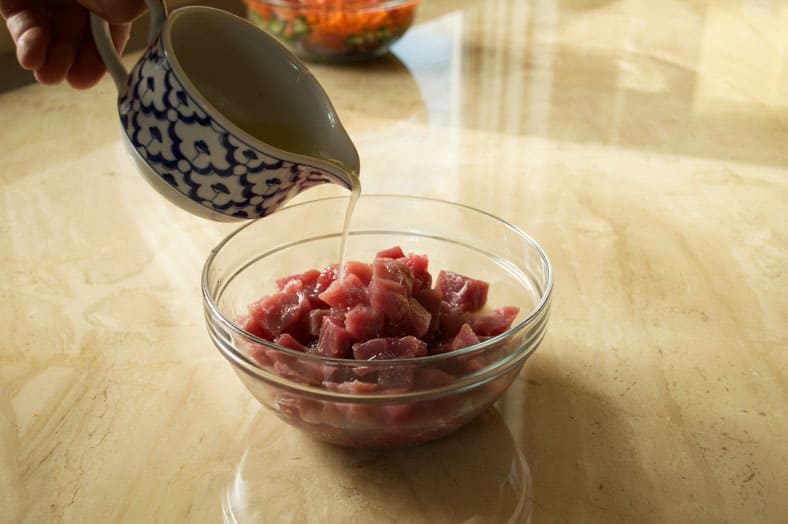
This type of cooking doesn’t take very long at all, and in fact it’s best that it doesn’t. Depending on the recipe, most anyone will advocate to “cook” your fish between only 10 and 20 minutes maximum, else the citric acid “overcooks” the fish and makes it tough.
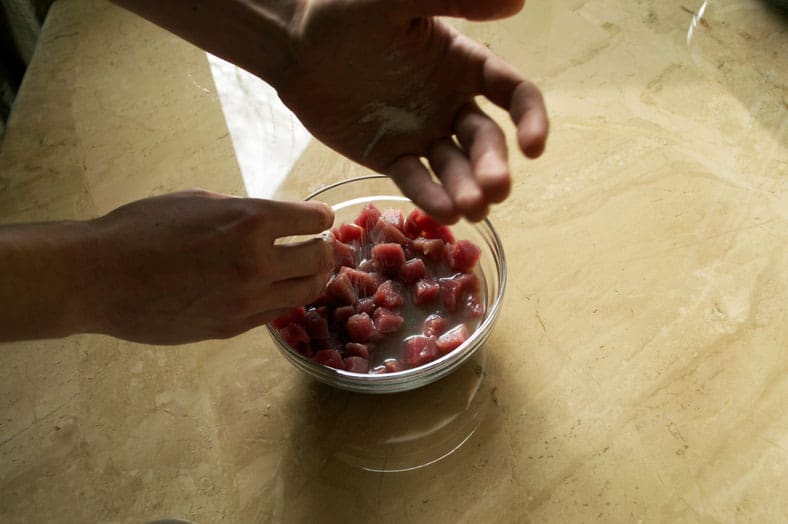
Besides the ceviched fish, this recipe is full of vibrantly colored and flavored vegetables, and then there’s the coconut milk. Once the raw fish and vegetables have been mixed together, you drizzle coconut milk and mix through to give a smooth flavor that beautifully counterbalances the tart flavor that comes from the citrus influence.
Our Take on the Recipe
Given the simplicity of the core poisson cru recipe, there is not all too many changes that we made to our original reference recipe.
When it came to sourcing our fish for this recipe (and we would really caution you to do the same as well), we were extra careful and made extra sure to make sure that we got the right type of quality fish that’s usable for raw consumption. While ceviche-style preparation will give a similar denaturation result to your fish’s proteins, it will not kill bacteria the way that heat cooking will.
For this reason, it’s really of the utmost importance to get fresh, preferably wild caught raw fish. Here in the US, the term sushi-grade usually denotes a reasonable quality, but the best way to be sure is to ask your fishmonger.
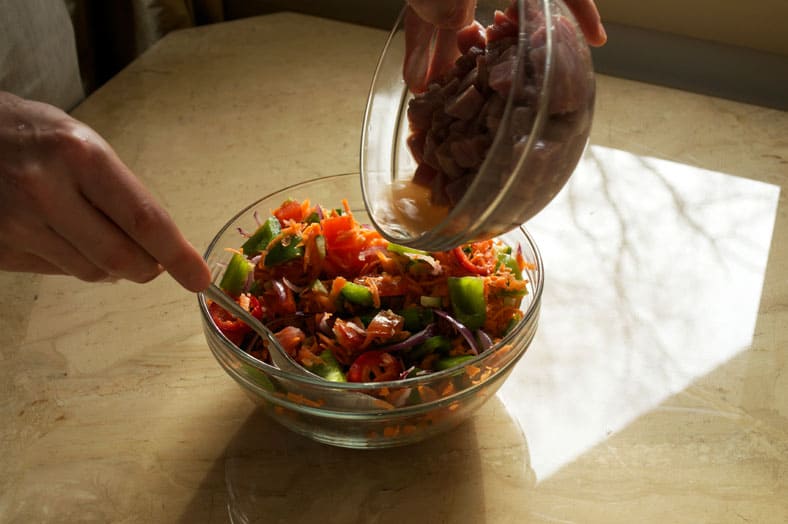
For “cooking” our fish, we erred closer on the earlier side of cooking than the later side. This is more a personal preference of ours, but we’d rather prefer having slightly fuller and chewier pieces of fish rather than perhaps “overcooked” and tougher more tart pieces.
One particular tweak we really enjoyed doing was including some of the “cooking” lime juice into the final dish. Most recipes will drain all or most of the lime juice, but we found that adding back some of the lime juice which our tuna cooked in gave more balance to the taste.
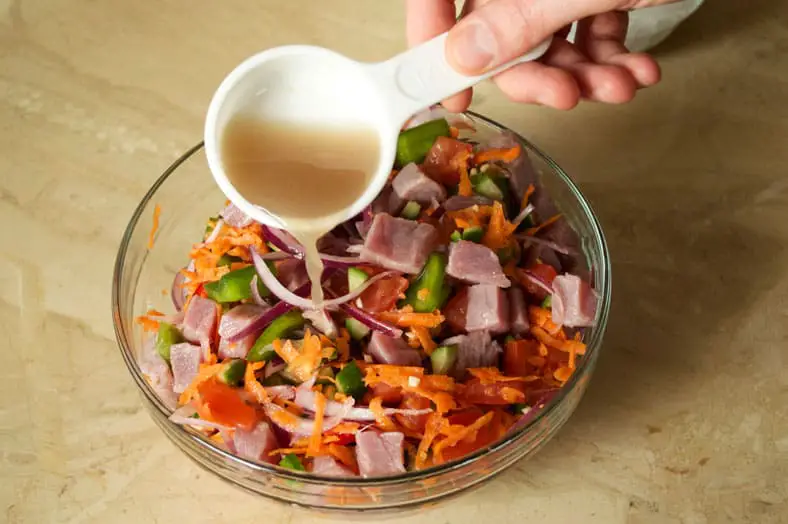
Other than that, there is not all too much else that we changed to this fantastic recipe.
Fresh and mild while zesty and tart all at once, it’s the quintessential Polynesian recipe and a great window into Tahitian cuisine. Bonus points that it’s so incredibly fun and easy to make too!
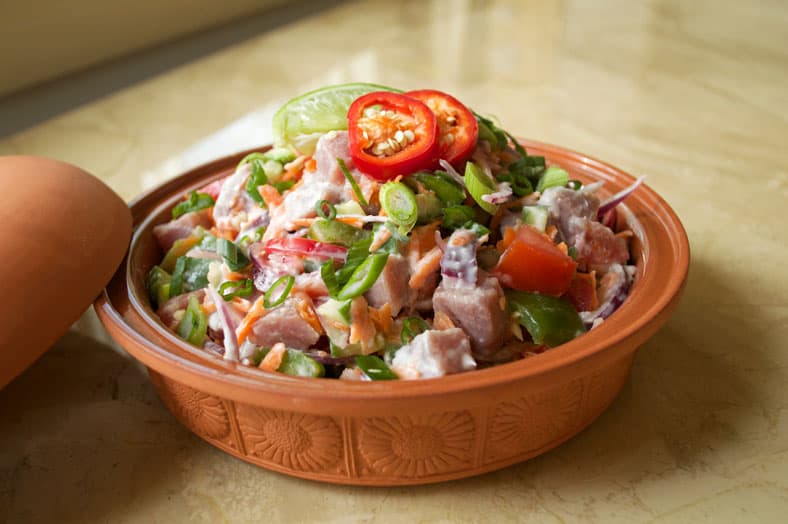
Have you tried poisson cru, or do you make it at home too? Share your experiences by commenting below!

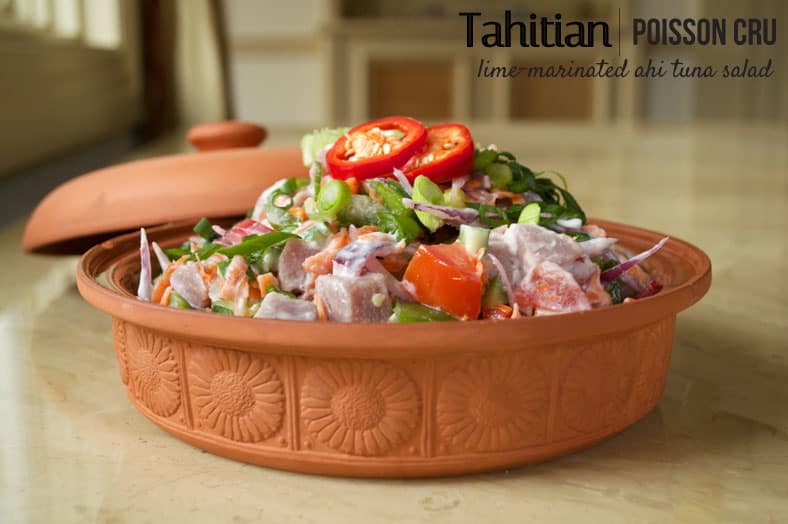
Heather,
This dish is reminiscent of ahi poke, one of the staples of my sushi lunches when we lived in Hawaii. I like how different cultures will use similar ingredients and create totally different and very delicious meals.
Thanks!
So true, Kirsten.. that’s the real beauty of cooking, isn’t it? And we haven’t had a good ahi poke in a while.. thanks for the reminder that we need to have some soon 🙂
We do something similar in the Phillippines called “Kilawin.” This dish looks delicious!
Oh that’s so cool! We’re adding Kilawin to the list of recipes we’re trying out soon then 🙂